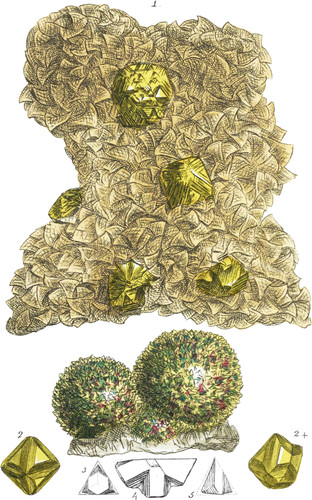 Enlarge
Enlarge
British Mineralogy
Sulphuret of Copper
The yellow Copper pyrites found at Ecton is remarkable for its variegated tints. The crystals belong to a modification rarely found elsewhere, and besides vary much in the proportion and number of their faces, either resembling the tetrahedron or octahedron in their general contour, and are mostly disposed in confusion, sometimes mackled and often very difficult to discriminate, yet occasionally showing great regularity, altogether calculated to try the most skilful in the science. The modifications from winch these crystals result, would, if regular, producte six facets upon each angle of the tetrahedron, inclined in pairs at obtuse angles, over the faces of the tetrahedron, in all 24 (see f. 3): it seldom happens that more than eight of these facets occur upon one crystal, and often only two or three, which are occasionally so enlarged as to occupy nearly the whole of the faces of the regular primitive tetrahedron, changing it into an irregular one: these secondary faces are distinguishable by striæ, (see f. 5.) Sometimes the angles of the tetrahedron are truncated, leading to the octohedron, I have one or two specimens containing this form, in which generally three crystals are joined together by the faces of the tetrahedron, so as to produce a kind of stellated mackle, as shown in the middle outline, f. 4. in which the striated faces belong to the modification above-mentioned; there are but two large ones upon each face of the tetrahedron, but there are also minute striæ indicating others. The edges of the tetrahedron also are truncated, this is a very curious specimen, for so much symmetry is rarely produced by modifications so incompletely formed. This sort of Copper pyrites is most commonly found on balls of Sulphate of Barytes, see tab. 96. and Carbonate of Lime; I possess a magnificent specimen two feet long and one wide, with these more or less compounded, from Ecton, helping the ideas in the contemplation of the vastness and grandeur nature occasionally exhibits, and hence creating a wonder that we do not pay more attention to the lessons to be learnt from her in our architectural ornaments, which are generally mere copies of unnatural fancies, rather than imitations of the sublime and natural.
The larger figure on this plate exhibits several groups of octohedrons with their edges truncated, fig. 2, they also are mackled as is shown in figure 2+.; the mackle is, I believe, new and rare: the specimen is a Cumberland one, its matrix pearly Carbonate of Iron.

